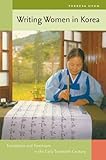Writing Women in Korea : Translation and Feminism in the Early Twentieth Century / Theresa Hyun.
Material type: TextPublisher: Honolulu : University of Hawaii Press, [2003]Copyright date: ©2003Description: 1 online resource (192 p.)Content type:
TextPublisher: Honolulu : University of Hawaii Press, [2003]Copyright date: ©2003Description: 1 online resource (192 p.)Content type: - 9780824826772
- 9780824843540
- 418/.02/08209519 23
- P306.8.K6 H98 2004eb
- online - DeGruyter
- Issued also in print.
| Item type | Current library | Call number | URL | Status | Notes | Barcode | |
|---|---|---|---|---|---|---|---|
 eBook
eBook
|
Biblioteca "Angelicum" Pont. Univ. S.Tommaso d'Aquino Nuvola online | online - DeGruyter (Browse shelf(Opens below)) | Online access | Not for loan (Accesso limitato) | Accesso per gli utenti autorizzati / Access for authorized users | (dgr)9780824843540 |
Frontmatter -- Contents -- Preface -- Introduction -- Chapter One. Cultural Background -- Chapter Two. European Heroines in Translation: The Search for New Models -- Chapter Three. Translation and New Feminine Ideals in the 1920s and 1930s -- Chapter Four. Women Literary Translators in the 1920s and 1930s -- Chapter Five. Translation, Gender, and New Forms of Writing in the 1920s and 1930s -- Conclusion -- Appendix -- Notes -- Selected Bibliography -- Index -- About the Author
restricted access online access with authorization star
http://purl.org/coar/access_right/c_16ec
Writing Women in Korea explores the connections among translation, new forms of writing, and new representations of women in Korea from the early 1900s to the late 1930s. It examines shifts in the way translators handled material pertaining to women, the work of women translators of the time, and the relationship between translation and the original works of early twentieth-century Korean women writers. The book opens with an outline of the Chosôn period (1392-1910), when a vernacular writing system was invented, making it possible to translate texts into Korean--in particular, Chinese writings reinforcing official ideals of feminine behavior aimed at women. The legends of European heroines and foreign literary works (such as those by Ibsen) translated at the beginning of the twentieth century helped spur the creation of the New Woman (Sin Yôsông) ideal for educated women of the 1920s and 1930s. The role of women translators is explored, as well as the scope of their work and the constraints they faced as translators. Finally, the author relates the writing of Kim Myông-Sun, Pak Hwa-Sông, and Mo Yun-Suk to new trends imported into Korea through translation. She argues that these women deserve recognition for not only their creation of new forms of writing, but also their contributions to Korea's emerging sense of herself as a modern and independent nation.
Issued also in print.
Mode of access: Internet via World Wide Web.
In English.
Description based on online resource; title from PDF title page (publisher's Web site, viewed 02. Mrz 2022)


